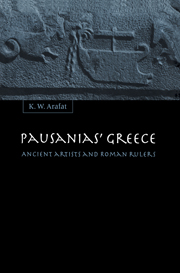Book contents
- Frontmatter
- Contents
- Map of Roman Greece
- Preface and acknowledgements
- List of abbreviations
- Chapter 1 Introduction
- Chapter 2 Pausanias on the past
- Chapter 3 Pausanias on the rulers of Roman Greece 1: introduction, Mummius and Sulla
- Chapter 4 Pausanias on the rulers of Roman Greece 2: Caesar and Augustus
- Chapter 5 Pausanias on the rulers of Roman Greece 3: Nero to Marcus Aurelius
- Chapter 6 Pausanias on Herodes Atticus and other benefactors
- Chapter 7 Conclusions
- Bibliography
- Index of Pausanias passages cited
- Index of other authors and passages cited
- General index
Chapter 5 - Pausanias on the rulers of Roman Greece 3: Nero to Marcus Aurelius
Published online by Cambridge University Press: 22 September 2009
- Frontmatter
- Contents
- Map of Roman Greece
- Preface and acknowledgements
- List of abbreviations
- Chapter 1 Introduction
- Chapter 2 Pausanias on the past
- Chapter 3 Pausanias on the rulers of Roman Greece 1: introduction, Mummius and Sulla
- Chapter 4 Pausanias on the rulers of Roman Greece 2: Caesar and Augustus
- Chapter 5 Pausanias on the rulers of Roman Greece 3: Nero to Marcus Aurelius
- Chapter 6 Pausanias on Herodes Atticus and other benefactors
- Chapter 7 Conclusions
- Bibliography
- Index of Pausanias passages cited
- Index of other authors and passages cited
- General index
Summary
Apart from Augustus, the only Julio-Claudian emperor to whom Pausanias pays significant attention is Nero, the starting point for this chapter. Pausanias' few references to the remaining Julio-Claudian emperors were considered in the first part of chapter 3, along with the reasons behind his omitting some emperors altogether (namely Galba, Otho, Vitellius, Domitian, Nerva and Titus). The fact that the greater part of this chapter is devoted to Hadrian accurately reflects the distribution of Pausanias' writings on the emperors of this period. I argued in chapter 1 for the importance of Hadrian in shaping the world in which Pausanias grew up, and the points made there should be borne in mind here.
As well as Pausanias' view of Nero and Hadrian, his brief references to Vespasian, Trajan, Antoninus Pius and Marcus Aurelius are also discussed in this chapter.
NERO
Nero may be regarded as the second most philhellene of the emperors whose reigns are covered in this study, after Hadrian. Like Claudius, he was a speaker of Greek. The most celebrated aspect of his philhellenism was his visit to Greece in ad 66/7, particularly his declaration of freedom for Achaia at the Isthmian games.
More than in the case of other emperors extensively treated by Pausanias (and he has more to say on Nero than on any bar Augustus and Hadrian), Nero's character forms a constant theme. The general attitude of the sources towards Nero is hostile, and Pausanias' account will be compared with those sources.
- Type
- Chapter
- Information
- Pausanias' GreeceAncient Artists and Roman Rulers, pp. 139 - 190Publisher: Cambridge University PressPrint publication year: 1996

